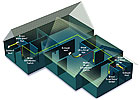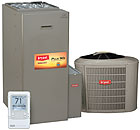Easier installations and reduced wiring are benefits to HVAC contractors. Improved comfort and reliability are the benefits for customers whose ventilation, air-cleaning, and humidity-control products are tied into relatively sophisticated home networks. The entire system is coordinated through the HVAC system.

The Broan-Nutone SmartSense ventilation system combines smart control technology with the company’s Ultra Silent ventilation fans, creating an integrated ventilation system in the home that meets both the intermittent and constant airflow rates required by ASHRAE’s residential ventilation standard. (Illustration courtesy of Broan-Nutone.) (Click on the image for an enlarged view.)
SMART VENTILATION
“To maintain a healthy home, it’s important to exhaust stale indoor air and minimize opportunities for mold and mildew growth through continuous ventilation throughout the day,” said Tom Heidel, IAQ product manager, Broan-Nutone.The company’s SmartSense® ventilation system is said to improve air quality throughout the home automatically. Heidel said the product meets both the intermittent and continuous ventilation requirements of ASHRAE (American Society of Heating, Refrigerating, Air-Conditioning Engineers) Standard 62.
According to Heidel, this ventilation product combines patent-pending SmartSense technology with Broan’s Ultra Silent™ ventilation fans, creating an integrated ventilation system in the home. “Individual fans that once worked independently now work together to ensure fresh air throughout the day,” he said.
In addition to residential applications, the product has ventilation applications in classrooms. It also can provide points toward such green building programs as Leadership in Energy Efficient Design (LEED), the National Association of Home Builder’s Green Building Guidelines, and the Energy Star® Home program, the company said.

Each SmartSense ventilation system includes a master switch that monitors total run-time (manual and automatic) to deliver optimal ventilation from as many as 10 fans. (Photo courtesy of Broan-Nutone.)
SMART INSTALLATION
According to Heidel, the first step is to install those fans wherever ventilation is needed in the home - bathrooms, laundry room, and a workshop or recreation room.Next, SmartSense control is then connected to each fan. “One control is designated as the master,” Heidel said. “Using the ASHRAE formula based on the home size and number of bedrooms, the ventilation rate is entered into this control.” The remaining controls communicate with the master control through the use of wireless Insteon™ technology, which digitally communicates over power lines already installed in the home. No control wires are needed.
“The master control monitors the normal/manual usage of the fans in the home, such as during shower time,” Heidel said. “It calculates the volume of air ventilated and deducts this from the total ventilation required. If necessary, it will intermittently operate fans throughout the home to achieve optimal ventilation and superior distribution of fresh air.”
The control system continually monitors and activates the fans day and night, operating them when necessary to distribute fresh air. The product won an AHR Expo Innovation Award in the ventilation category.
COMMERCIAL HUMIDITY
Lennox also won an Innovation Award, this one in the IAQ category, for its Humiditrol® product. “We’re pretty proud of how easy this is to use,” said Tim Wallaert, Lennox director of Controls Product Management. “Guys are able to correct problems quickly.“Ease of use has been our watchword,” he said. “You’ve got pressure and temperature sensors in the rooftop units; all that gets back to the Integrated Modular Controller (IMC). You can quickly diagnose if you’ve got something out of balance. You’ll find a problem pretty quick in commissioning.
“For contractors, the biggest thing is that they’re easy to install, and they’re easy for the building operator to use,” Wallaert said. “We have our L Series and S Class rooftop units with the IMC.” The Humiditrol connects with a two-wire connector. “Somebody who is already familiar with the Lennox rooftop unit is already familiar with the installation,” he said.
Advanced control logic and multiple staging options allow the system to independently control space temperature and humidity levels, he said. Customizable settings include relative humidity, setpoint, deadband, and reheat options through outdoor air.
“Essentially it’s a secondary reheat coil,” he said. “The cooling process itself dehumidifies. The problem is, that doesn’t always improve your comfort. Before you were warm and clammy and now you’re cold and clammy. The coil gently warms air back up. Sensors can detect the humidity level without bringing on cooling.”
The same technology is being used on the company’s residential side. “You run the cooling process, then Humiditrol warms it back up,” Wallaert said. “What ends up happening is, you’re not driving the system as long or as hard. You don’t have the extreme cycles. The equipment doesn’t come out of first stage.”

Bryant’s Evolution control lets homeowners monitor and manage temperature, humidity, dehumidification, ventilation, IAQ, and airflow. (Photo courtesy of Bryant.)
RESIDENTIAL IMPROVEMENTS
Products such as the Rheem and Ruud Comfort Control System (CCS) are examples of the massive expansion of smart controls in the residential market. Their impact on IAQ is considerable.“Products using electronic controls have laid the groundwork for the future of integrated home comfort systems that include variable-speed air handlers with electronic controls, advanced onboard diagnostic systems, interactive systemwide communication ability, and whatever can be imagined as part of a total home comfort package,” said Rheem Air Conditioning.
Two-speed compressors, on-demand dehumidification, variable-speed motors requiring field configuration, advanced controls, and IAQ products have become more common; however, they have tended to operate independently. Rheem’s CCS provides component integration and systemwide communications, allowing these individual components to be linked. They share operational tracking, diagnostic information, and system control.
The control system reaches out to these individual components during installation, operating them for optimum comfort and good IAQ.
Interestingly, Rheem offers this microprocessor technology on residential condensers from 13 to 18 SEER, and on some models offering R-22 or -410A. “Rheem doesn’t see this as an ultra-high-efficiency product line,” said Mark King, the company’s residential outdoor product manager. “Giving consumers and contractors the ability to connect isn’t just limited to higher efficiency. We feel like, as more homeowners become aware of this and the ability of the system, we will see some pull-through demand.
“The truth is, 85 percent of the industry is in the 13 SEER segment,” he said. “Why not introduce the technology that is available?”
Kelvin Kleman, engineering manager, electronics and controls, said the CCS module put diagnostic features in the control. “If the tech is wanting to troubleshoot, there’s local diagnostics in the outdoor unit. And there is a seven-segment display so he’s not sitting there counting blinks.”
He continued, “We want to provide the contractor with the means to know that he has a good installation. He could go back to a database to know that it is correct. I think our whole landscape is changing - people being a whole lot more aware of energy costs, the impact of energy usage, global warming - those things are really starting to impact our industry.”

These Hybrid Heat units from Bryant utilize the Evolution control to determine the optimum point at which to switch from one heating fuel to another. (Photo courtesy of Bryant.)
‘SIX CONTROLS IN ONE'
Bryant said its Evolution eControl combines six controls in one, letting homeowners monitor and manage temperature, humidity, dehumidification, ventilation, IAQ, and airflow. Using the Internet or phone, the system sends homeowners notifications on required maintenance or service via e-mail, phone, or pager messages with remote access option.The control also offers maintenance reminders with the dealer name and phone number, day-at-a-glance programming, and vacation scheduling. TrueSense™ dirty filter detection is included in the thermostat messages.
A utility interface connection and up to 23 point diagnostics are said to reduce dealer callbacks, troubleshooting, and installation time. The four-wire, color-coded control and an automatic startup feature help dealers spend less time at the jobsite.
Nordyne’s iQ Drive control system uses a proportional band controller, which the company says operates better than a typical thermostat, allowing the system to run continuously in various modes to work as a dehumidifier. Features such as UV lights and air filters are controlled through the system, providing home comfort and efficiency. The iQ Drive also notifies the homeowner when servicing is required and provides the service technician’s contact information.
These unitary systems have a major subsystem in common: UltraTech™, a communicating system.

What’s the operating difference between a unitary system with UltraTech and one without? Here’s a quick, visual comparison. (Graphic courtesy of Emerson Climate Technologies.) (Click on the image for an enlarged view.)
EMERSON'S ULTRATECH
Emerson Climate Technologies’ UltraTech is an integrated network of components that work together in the HVAC system.“Our market research shows that homeowners want better comfort and efficiency, with systems that are highly reliable,” said John Schneider, director of marketing, Emerson Climate Technologies, Residential Systems. “However, these systems are often more complex to install. Most contractors agree that UltraTech enables them to upsell better performance to the homeowner with smart HVAC systems they can install and service with confidence.
“We are really seeing a key trend coming into this market, putting key features that add value, particularly smart systems,” Schneider said. “It’s really changing the shape of the market, enabling contractors to do a lot more for their customers.”
In addition to energy awareness, “We are seeing a growing need at the homeowner level for better comfort. Today’s systems are often more complex to install. A contractor with an indoor variable-speed blower would have to manually set dipswitch settings and run wire to the thermostat.” These can be deterrents to selling advanced systems, Schneider said. “Sometimes they will say things like, ‘Only one of my service crews are capable of selling these high-end systems.’
“That’s where UltraTech fits in. It’s a communicating system where messages can be sent to different nodes of the system; it can share information systemwide, allowing you to autoconfigure system settings. It can automatically adjust system settings for specific equipment. Components reach out and gather information from the system. It looks out and sees what hardware is there; that’s the beauty of autoconfiguration.”
Instead of having a lot of wires for each command line, Schneider said, “it’s a true communicating system. There are two wires for line power and two wires for the communicating line. It sends messages back and forth through the nodes of the system.” The basic system consists of three primary nodes: thermostat, outdoor unit, and indoor unit. Systems can be expanded to include a humidifier, dehumidifier, air-cleaning products, ERVs, and HRVs.
Contractors who used to say only one crew could install the high-end systems now are saying, “All of my guys can install it,” Schneider said. “It’s an enabler for contractors to sell and install systems that provide greater comfort and efficiency.”
For more information, visit www.broan.com, www.bryant.com, GoToEmerson.com, www.lennox.com, www.nordyne.com, and www.rheem.com.
Publication date:01/29/2007

Report Abusive Comment